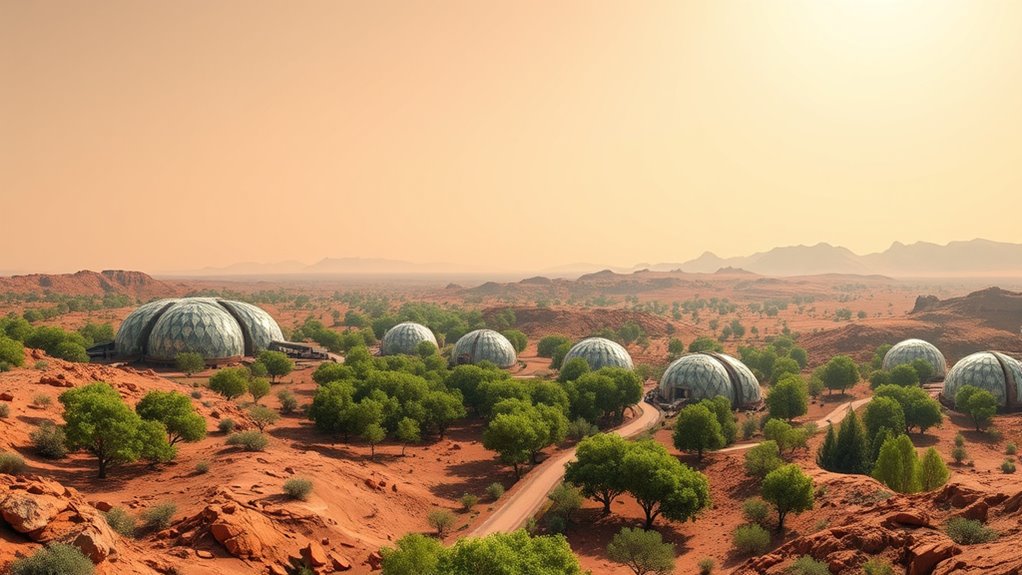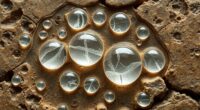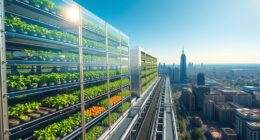Mars terraforming simulations serve as vital blueprints for creating sustainable parks and habitats on the Red Planet. They help you visualize and test environmental changes, such as atmospheric adjustments and climate control, before actual implementation. These models guide you in designing eco-friendly ecosystems, deploying technology, and managing challenges. By exploring these advanced simulations, you’ll gain a better understanding of how future Mars parks could become a reality—and there’s more to discover on how they can transform the planet.
Key Takeaways
- Simulations model environmental conditions and infrastructure needed for sustainable Mars parks, guiding effective terraforming strategies.
- They help optimize climate regulation techniques, such as atmospheric gas release and surface albedo adjustments, for habitat creation.
- Virtual testing of ecological systems—microbial and plant-based—ensures resilient ecosystems within Mars parks.
- Advanced simulations identify potential challenges, allowing for refinement of technology and safety measures before implementation.
- These models serve as detailed blueprints, enabling efficient planning and development of self-sustaining Mars park environments.
The Role of Virtual Models in Mars Colonization Planning

Virtual models play a crucial role in Mars colonization planning by allowing scientists and engineers to simulate complex environmental conditions and infrastructure designs before physical implementation. These digital replicas help you test ideas for space mining operations, ensuring equipment can operate remotely and efficiently on the Martian surface. Robotic automation becomes essential here, as virtual models enable you to optimize robotic systems for tasks like resource extraction and habitat construction without risking real equipment or lives. By running detailed simulations, you can identify potential challenges, refine technology, and improve mission safety. This proactive approach saves time and resources, making the entire process more predictable. Ultimately, virtual modeling becomes your blueprint for developing sustainable, automated systems that support future human settlement on Mars. Automation technologies further enhance the ability to simulate complex tasks, ensuring that systems are reliable before deployment.
Key Factors Considered in Terraforming Simulations

When running terraforming simulations, you focus on adjusting the atmosphere’s composition to make it breathable and sustainable. You also need to reflect on how to control surface temperatures to support life and maintain stability. Additionally, planning water availability strategies is essential for creating a habitable environment on Mars. Incorporating advanced environmental monitoring techniques can help optimize these factors for long-term success.
Atmospheric Composition Adjustments
How can we effectively modify Mars’s atmosphere to support Earth-like conditions? You need to consider balancing terraforming ethics and planetary protection. Adjusting the atmospheric composition involves adding greenhouse gases to trap heat and increase pressure, making the environment more hospitable. You might release gases like methane or use industrial processes to produce oxygen and nitrogen. Additionally, understanding fetal development stages can inform the timing of such interventions to optimize safety and effectiveness. However, you must weigh the ethical implications of altering a planetary body and guarantee that your actions don’t harm potential native ecosystems or future scientific research. Careful planning helps prevent irreversible damage, aligning with planetary protection principles. These adjustments are vital for creating a stable, breathable atmosphere, but they require responsible approaches that respect both the planet’s integrity and broader ethical considerations.
Surface Temperature Regulation
Regulating Mars’s surface temperature in terraforming simulations requires careful consideration of several key factors. One critical element is the presence of polar ice, which acts as a natural thermal regulator. Melting or expanding polar ice can help warm the planet, but excessive ice can increase surface albedo, reflecting sunlight and cooling the surface. Adjusting surface albedo is essential; darker materials or engineered surfaces can absorb more heat, raising temperatures, while lighter surfaces reflect sunlight to prevent overheating. Balancing these factors helps maintain stable temperatures suitable for future ecosystems. Additionally, understanding the impact of color accuracy on visual assessments is vital for evaluating surface conditions during simulation analysis. By strategically managing polar ice and surface albedo, you can create a more habitable Martian climate, ensuring temperature stability that supports ongoing terraforming efforts.
Water Availability Strategies
What strategies can guarantee sufficient water availability to support Martian ecosystems? You can focus on harnessing existing resources like polar ice caps and subsurface water. First, you might melt polar ice using solar reflectors or localized heating to release water. Second, drilling into subsurface water reservoirs can tap into hidden supplies, ensuring a steady source. Third, redirecting water vapor from the atmosphere through greenhouse gases or artificial feedback loops could increase surface moisture. Fourth, establishing water recycling systems within habitats ensures minimal loss. Combining these methods maximizes water availability, supporting plant growth and microbial life. Additionally, employing data-driven strategies can help monitor and optimize water distribution in real-time. By carefully managing polar ice and subsurface water, your terraforming plan can create a sustainable water cycle, making Mars more hospitable for future ecosystems.
Advances in Atmospheric and Climate Engineering Technologies
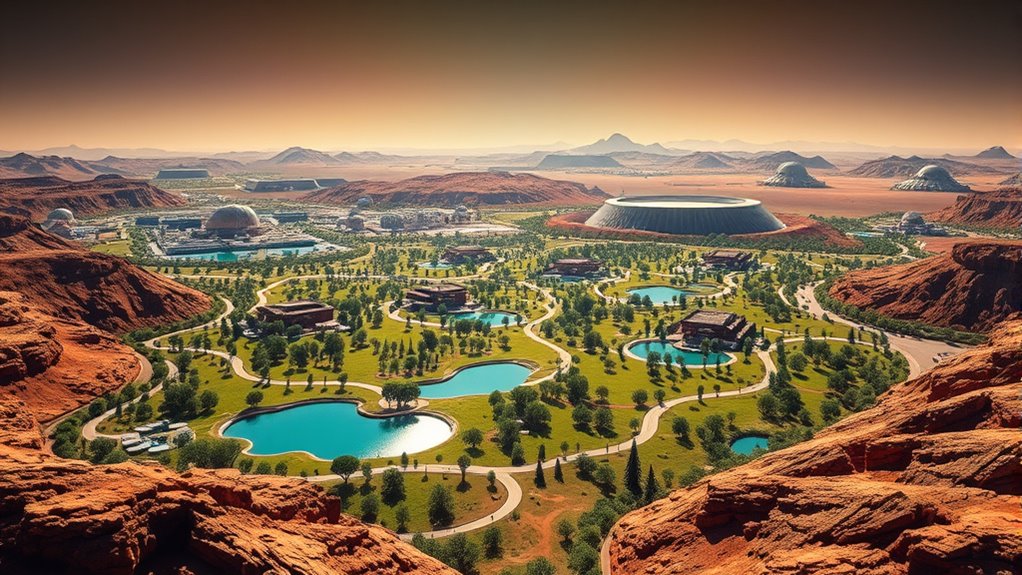
Recent advances in atmospheric and climate engineering technologies have considerably enhanced our ability to transform Mars into a habitable environment. By studying Mars geology, scientists develop strategies to release greenhouse gases, trapping heat and thickening the atmosphere. These techniques help stabilize surface temperatures and promote liquid water stability. Radiation shielding techniques have also improved, enabling us to better protect future habitats from harmful cosmic rays and solar radiation. Innovations like reflective aerosols and underground shielding materials can markedly reduce radiation exposure. Additionally, Mazda Tuning techniques have inspired new approaches to optimizing environmental controls and energy efficiency on Mars. These technological progressions allow for more effective climate control and safer living conditions. As a result, we’re closer than ever to creating sustainable ecosystems on Mars, leveraging our understanding of Mars geology and advanced radiation shielding to pave the way for long-term human presence.
Potential Ecological Systems for Martian Habitats

You’ll want to contemplate how microbial life could sustain habitats on Mars, providing essential processes like nutrient cycling and waste management. Plant-based ecosystems also offer a way to produce food, oxygen, and stabilize the environment. Exploring these ecological systems helps identify practical solutions for maintaining life in Martian conditions. Incorporating mindfulness techniques into habitat management can improve crew well-being and focus during long-term missions.
Microbial Life Support
Could microbial life be the key to sustaining human habitats on Mars? It’s possible, especially with microbes that thrive in harsh conditions. They can help break down Martian mineralogy, turning rocks into usable nutrients. Microbes can also contribute to radiation shielding, creating a protective layer around habitats. Here’s how they support your mission:
- Enhance Soil Fertility: Microbes process Martian minerals, making soil suitable for future plant growth.
- Generate Oxygen: Certain microbes produce oxygen as a metabolic byproduct, aiding life support.
- Bioremediation: They can clean up waste and pollutants, maintaining a healthy environment.
- Radiation Resistance: Microbial communities can adapt to high radiation levels, helping sustain ecological stability.
- Vibrational Compatibility: Microbes can be engineered or selected for vibrational resilience, ensuring they remain effective in Mars’ unique environment.
Harnessing microbial life could be vital for building resilient, self-sustaining ecosystems on Mars.
Plant-Based Ecosystems
Building on microbial support, integrating plant-based ecosystems offers a promising way to establish sustainable life on Mars. By introducing Martian flora, you can begin creating self-sustaining habitats that contribute to soil restoration. Plants improve soil quality by fixing nutrients and stabilizing the surface, which is crucial given Mars’ barren landscape. As you develop these ecosystems, you’ll see how flora adapt to the unique environment, aiding in oxygen production and climate regulation. Incorporating hardy, engineered plant species can accelerate the creation of breathable atmospheres and fertile soil. Over time, these ecosystems will form the foundation for more complex life, transforming red plains into vibrant green habitats. Photosynthesis is a vital process that will help these plants generate oxygen and contribute to atmospheric rejuvenation. Ultimately, plant-based systems are essential for long-term ecological stability on Mars.
Challenges and Limitations of Current Simulation Methods
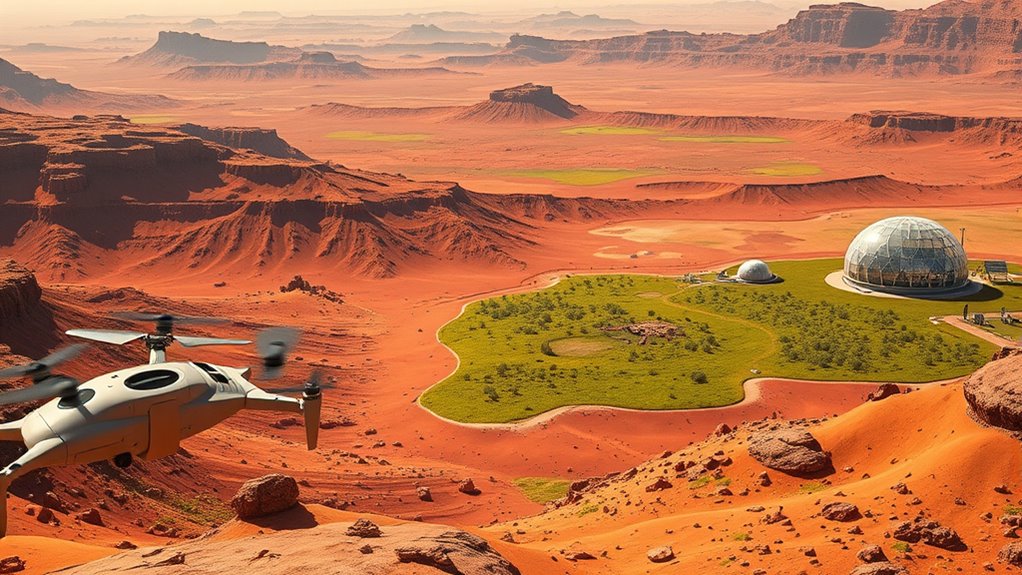
Despite advances in simulation technology, current methods face significant challenges that limit their accuracy and reliability. First, simulation accuracy suffers because models can’t fully replicate Mars’s complex environment, leading to simplified results. Second, computational constraints force you to reduce model detail, which impacts precision. Third, many simulations struggle with scaling issues, making it hard to predict long-term outcomes. Fourth, unpredictable variables like dust storms or atmospheric shifts aren’t always incorporated, skewing results. These limitations mean you can’t depend solely on current simulations to plan terraforming projects. Instead, they serve as rough guides. Overcoming these challenges will require better algorithms and more powerful hardware to improve both accuracy and scope. Additionally, incorporating advanced modeling techniques could help address some of these inherent limitations.
Future Prospects for Real-World Implementation
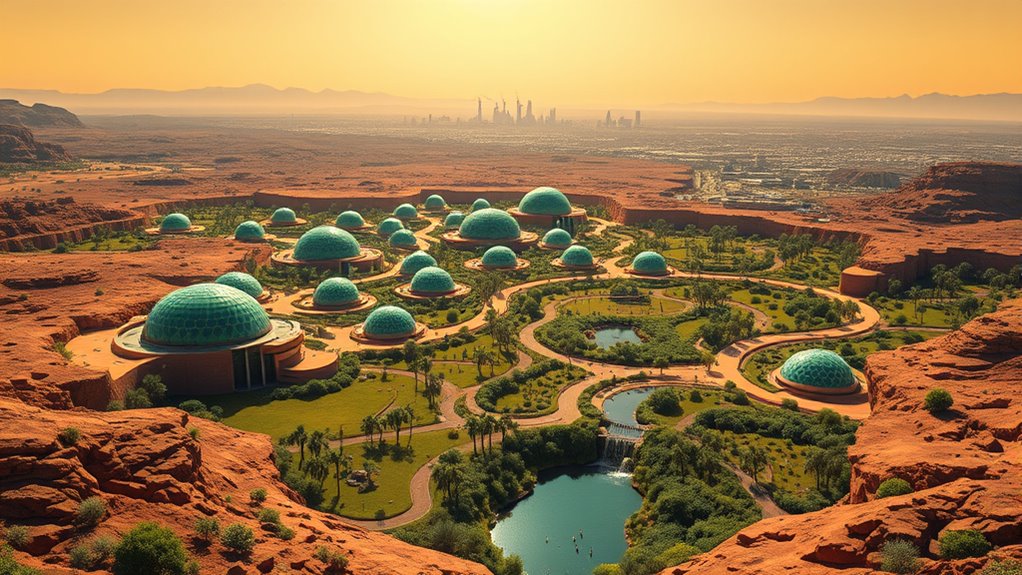
Advancements in simulation technology are paving the way for more practical implementation of Mars terraforming efforts. You can now better plan and test space agriculture techniques that will support sustainable food production on the red planet. Improved simulations enable you to optimize habitat design, ensuring structures withstand Mars’ harsh conditions while providing safety and comfort. As these tools become more accurate, they help bridge the gap between theory and reality, making large-scale projects feasible. You’ll be able to evaluate various terraforming methods, refine life support systems, and develop resilient ecosystems before actual deployment. Ultimately, these technological strides bring you closer to transforming Mars into a habitable environment, paving the way for future colonization and long-term human presence, with practical strategies rooted in proven simulation insights.
Frequently Asked Questions
How Accurate Are Current Simulations Compared to Actual Martian Conditions?
You might wonder about simulation accuracy compared to real Martian conditions. Currently, models provide valuable insights, but they face limitations due to incomplete data and complex environmental factors. While simulations help predict climate and surface changes, model limitations mean they can’t perfectly replicate Mars’s true environment. Continuous improvements in data collection and technology are essential to enhance their accuracy, making them more reliable guides for future terraforming efforts.
What Are the Ethical Considerations in Terraforming Mars?
Imagine transforming an untouched world, but consider planetary sovereignty and ecological ethics before you act. You’re faced with ethical questions about whether humans should alter Mars, risking its natural state. Do you prioritize exploration or respect for potential native ecosystems? Balancing scientific progress with moral responsibility is vital, ensuring that in our quest to colonize, we don’t compromise the intrinsic value of Mars itself.
Can Simulations Predict Long-Term Ecological Stability on Mars?
You might wonder if simulations can predict long-term ecological stability on Mars. While ecological modeling helps address terraforming challenges, it’s limited in forecasting future stability due to Mars’ unpredictable environment. Simulations provide valuable insights, but they can’t guarantee ecological balance over decades. You should view them as guides, not certainties, recognizing that unforeseen factors could influence Mars’ future ecosystems.
How Do Funding and Policy Impact Simulation and Terraforming Efforts?
You might think funding challenges and policy frameworks slow down progress, but they actually shape the direction of simulation and terraforming efforts. Adequate funding guarantees scientists have the resources to refine models, while clear policies foster international cooperation. Without strong policies, efforts may stagnate or clash, yet with them, you get a coordinated approach that accelerates innovation, making the vision of transforming Mars into a sustainable environment more achievable.
What Role Do International Collaborations Play in Mars Habitat Development?
International collaborations play a fundamental role in Mars habitat development by pooling resources, expertise, and funding from different countries. You benefit from diverse perspectives that foster technological innovation, making habitats more sustainable and resilient. Partnerships accelerate research, reduce costs, and share risks. By working together, you enhance the chances of successful Mars colonization, ensuring that advancements are accessible globally, and creating a unified effort toward establishing a human presence on the Red Planet.
Conclusion
As you explore these simulations, remember that over 40% of Mars’ surface could someday support human life, thanks to advanced terraforming models. While challenges remain, these virtual blueprints are essential for shaping real-world strategies. By understanding the complexities and potentials, you can see how close we are to transforming the Red Planet into a habitable world. It’s an exciting time—your imagination and innovation could make Mars’ future a reality.

